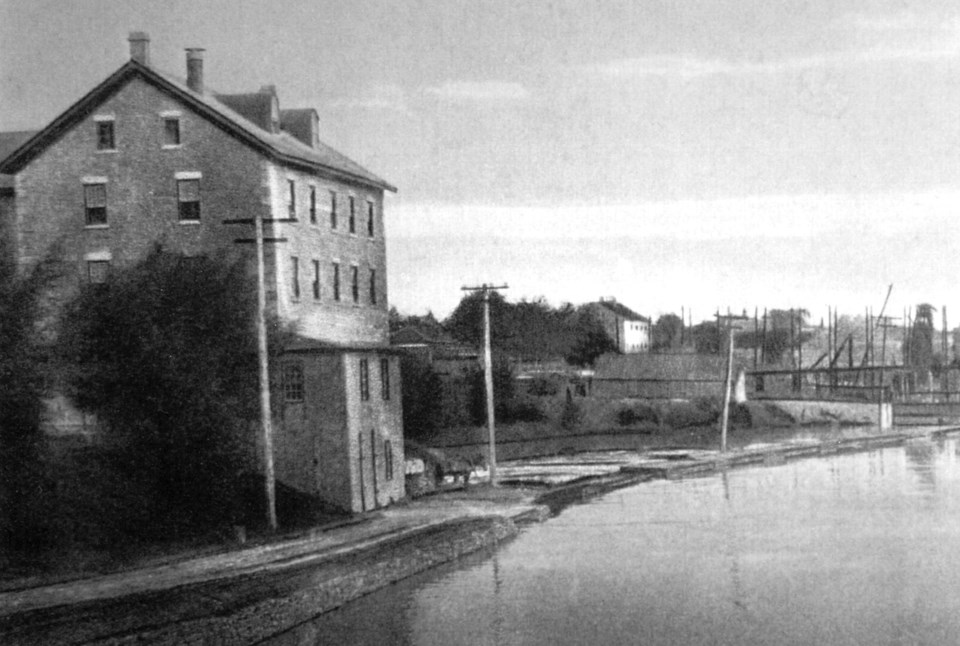After the Rebellion of 1837, a company of Redcoats—3rd Battalion, Incorporated Militia, was stationed here. The barracks were on the east side of Pine Street, a few doors north of Albert; the building was afterwards used for the grammar school. These men were followed by a company of the Royal Canadian Rifles; for when the work of enlargement began on the old Canal, only military force was sufficient to keep the peace among the excitable navies, who formed so large a proportion of the population.
From the opening of the Canal until the Manitoba wheat made its appearance upon the market, the Niagara district was unexcelled for the quantity and quality of its flour. A great many grist mills were in operation along the Canal, and thousands of barrels of flour were shipped each week to Montreal, and thence to Europe. hIn 1846, Jacob Keefer built the Welland Mills, then the largest in Canada. An advertisement in the Thorold Advocate in 1849 describes them as “in complete order for manufacturing from 200 to 300 barrels of flour per day, with ship elevator capable of discharging 1,000 bushels of wheat per hour, and storage for 70,000 bushels of wheat and 5,000 barrels of flour.”
The building is a substantial stone structure, and was later owned by the firm of Howland & Co., the senior partner being Sir William Howland, late Lieutenant-Governor of Ontario.
Other mills mentioned in an early issue of the Advocate give us some idea of the business done in Thorold then. The advertisements include the following: The Elgin Mills, owned by Alexander Christie, and capable of grinding and packing 150 barrels of flour per day; the Niagara Mills, owned by James Gibson, and able to grind and pack 120 barrels of flour a day; the Old Stone Mill, operated by George Keefer Jr.; and the Thorold Mills, owned by Parke and Cowan, and capable of grinding and packing 130 barrels of flour and 80 bushels of custom work per day.
In the same paper, we find mention of two other industries, arising out of the natural products of Thorold: Charles Cockburn’s Pottery on Pine Street, and Brown & McDonald’s Cement and Plaster Mill at Lock No. 18. The hotels open in that year included the Thorold House, the Welland Canal Inn, the Union House, the American Hotel, the Farmers’ Inn, the Welland Hotel and the Thorold Temperance House.
In “Canada Past, Present and Future,” the village of Thorold is credited with a population of 1,200 in 1849. The industries are described as: five grist mills, with an aggregate of 15 run of stones; one sawmill, containing one upright and two circular saws and two planing machines; and a machine shop and carding machine. Mention is also made of a tannery, a broom factory, a plough factory, a soap and candle factory, two potteries and a plaster mill.
In 1847, the first cotton woven in Canada was made at Thorold. The factory was owned by a company of enterprising citizens, but the management was not sufficiently economical, and the experiment proved a financial failure.
In 1858, the advertisements in the Thorold Gazette show what industrial progress the village was making. In it, D. W. Corbin advertises a new brick yard on the Ker farm, close to the Great Western Railway station at Thorold (later called Merritton Station); John Pollock’s new stone yard on Mill Street—now Clairmont—opposite the “New English Church” is mentioned; and Walter H. Ball advertises building stone for sale on the township line between Grantham and Thorold.
The list of manufactories includes John Brown’s cement and plaster mills, Morley’s plough factory, W. B. Hendershot’s sawmill (leased at that time by John McDonagh), and the Thorold Mills, bought from Gibson and Elliott by Band and Hutchison.
From 1850 until 1880 were Thorold’s brightest days. There was work for every labourer and mechanic; all the shops did a thriving business, and the factories found a ready market for all their wares. Throughout the Crimean War, fortunes were made by both farmers and millers in this district. A good story of one of the many quarrels between the mill owners and canal superintendents illustrates the wealth that was made here at the time.
In the early 1850s, John Woodward was one of the most prominent millers in Thorold, and he was frequently annoyed at finding the water turned off from his mill when there was not sufficient supply for navigation. Angry at the loss that idleness entailed, he once threatened to throw the superintendent into the Canal if the water was turned off again. At the next offence he carried out his threat, and when the government official reached the bank he threatened Woodward that the action should cost him $100.
“Friend,” calmly replied the miller, “I could afford to throw you in every day at that price, if my mills may run.”



